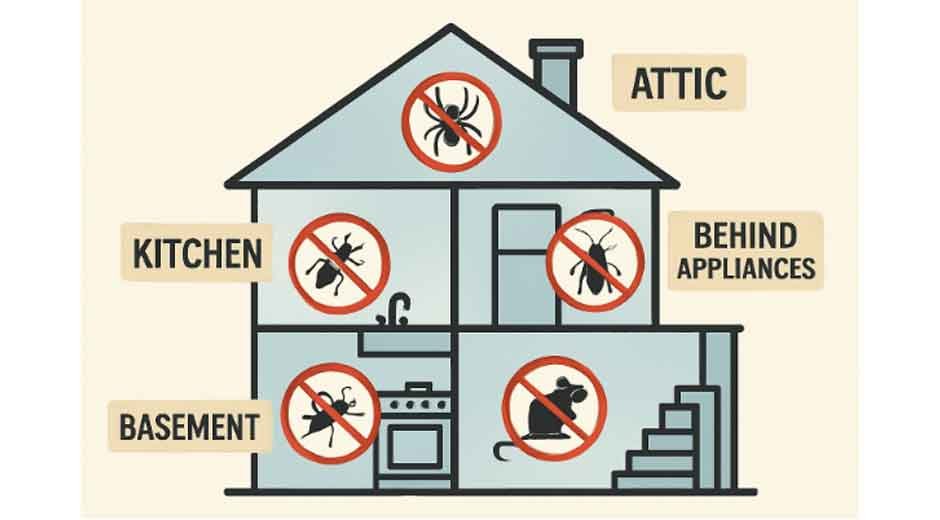Key Takeaways:
- Recognize the most common household pests and their signs.
- Learn practical, science-backed methods for pest prevention.
- Discover non-toxic and family-safe pest control solutions.
- Find out when professional help is needed for persistent problems.
- Understand the environmental impact of different pest control techniques.
Introduction
Keeping your home pest-free is not just a matter of comfort—it’s essential for the health and safety of your family. Effective pest control starts with understanding which pests are most likely to invade, what attracts them, and which strategies can keep them at bay without jeopardizing your home’s environment. If you’re struggling to protect your home and yard, partnering with a reputable lawn pest control company can make a significant difference in maintaining a safe and pest-free property.
DIY methods and professional services both play a role in an integrated pest management approach. Determining when you can handle issues on your own or when you need expert intervention is vital for long-term results. Below, you’ll find a comprehensive guide rooted in best practices and science-backed solutions to help you minimize pest threats.
Common Household Pests and Where They Hide
Common household pests include ants, cockroaches, spiders, rodents, and termites, each with their preferred habitats and hiding spots. Ants are drawn to kitchens, cockroaches hide in dark corners, spiders prefer seldom-disturbed spaces, rodents seek warm, sheltered areas near food sources, and termites establish colonies in wall voids and foundations. Geography and climate also play a role, with humid regions experiencing more pest issues, while arid regions may face ants and spiders.
Spotting Early Signs of Infestation
Early detection is crucial for preventing pest problems from escalating into major issues. Common signs include droppings, gnaw marks, shed skins, and nests. Pests leave telltale evidence, such as termites, ants, spiders, and rodents. For rodents, the Centers for Disease Control and Prevention provides detailed information and safety guidance. Identifying these signs early helps prevent an infestation and prevents further damage.
Simple Steps for Everyday Pest Prevention
- Cleanliness:Keep counters, floors, and pantries free of crumbs and spills to deny pests their most basic need: food.
- Sealing Entry Points:Inspect your home for gaps around doors, windows, and utility penetrations. Use caulk or weatherstripping to seal any cracks.
- Proper Food Storage:Store dry goods in sealed containers and keep produce refrigerated when possible.
- Regular Inspections:Set a calendar reminder for monthly checks in vulnerable areas like basements, attics, and beneath sinks.
Natural and Pet-Friendly Pest Control Methods
Non-toxic solutions like essential oils, diatomaceous earth, and baking soda are critical for families with children or pets to repel insects. These solutions are lower-risk but may be less potent than chemical treatments and require persistence and regular application. It’s crucial to research which solutions are safe for specific pets, as some essential oils can be toxic to cats, dogs, or birds.
Eco-Conscious Pest Control Choices
Chemical pest control products can negatively affect soil, water, and beneficial insect populations. Choose products labeled as low-toxicity or certified by environmental organizations, and always follow application instructions carefully. Look for integrated pest management (IPM) strategies, which focus on prevention, monitoring, and targeted solutions rather than blanket chemical coverage.
Many pest control professionals now offer eco-friendly service options. You can consult the EPA’s safe pest control guidance to review best practices and learn how to make environmentally responsible decisions for your household.
DIY Remedies Versus Professional Pest Control
DIY remedies are often effective for small-scale or early-stage problems, especially when using traps, baits, or natural repellents. However, improperly applied DIY treatments can worsen infestations or create health risks—such as misusing over-the-counter pesticides or delaying action until pests have firmly established themselves.
Persistent, recurring, or large infestations—particularly involving termites, bed bugs, or rodents—usually warrant professional intervention. Experts can identify the extent of the issue, select the safest and most effective solutions, and ensure treatments are applied in accordance with local regulations.
Seasonal Tips to Keep Pests Outside
- Spring:Repair screens, seal gaps, and clean up yard debris that may have accumulated over winter.
- Summer:Watch for increased bug activity, empty standing water to reduce mosquito breeding, and keep garbage tightly sealed.
- Fall:Inspect and seal cracks, as rodents often seek warmth indoors when temperatures drop.
- Winter:Store firewood away from the house, check for pests in attic insulation, and ensure crawl spaces remain dry.
Knowing When to Call for Help
Some situations call for immediate professional attention: widespread infestations, evidence of structural damage (like that from termites), repeated failed DIY efforts, or safety concerns involving venomous pests or rodent droppings. Waiting too long can put your property—and your family’s health—at risk, as pests multiply quickly and can cause significant damage.
Conclusion
Keeping pests at bay doesn’t have to mean harsh chemicals or endless frustration. By combining preventative habits, environmentally friendly solutions, and targeted treatments when necessary, homeowners can protect both their living spaces and their well-being. The most effective pest control strategies are those that balance safety with efficiency—addressing the problem while preserving a healthy home environment.
Ultimately, proactive care and smart choices ensure that your house remains a safe, comfortable place to live—without uninvited guests.


